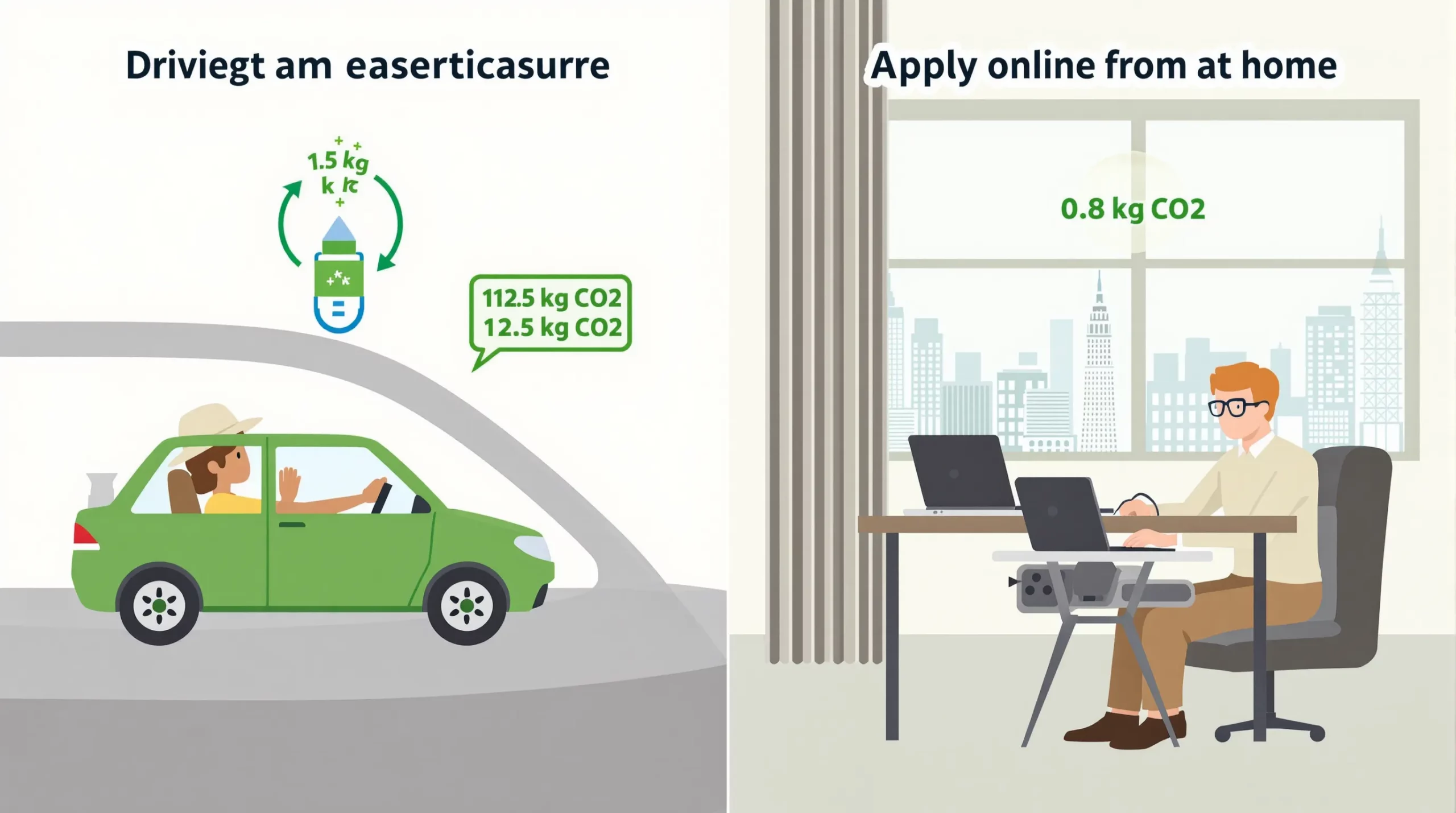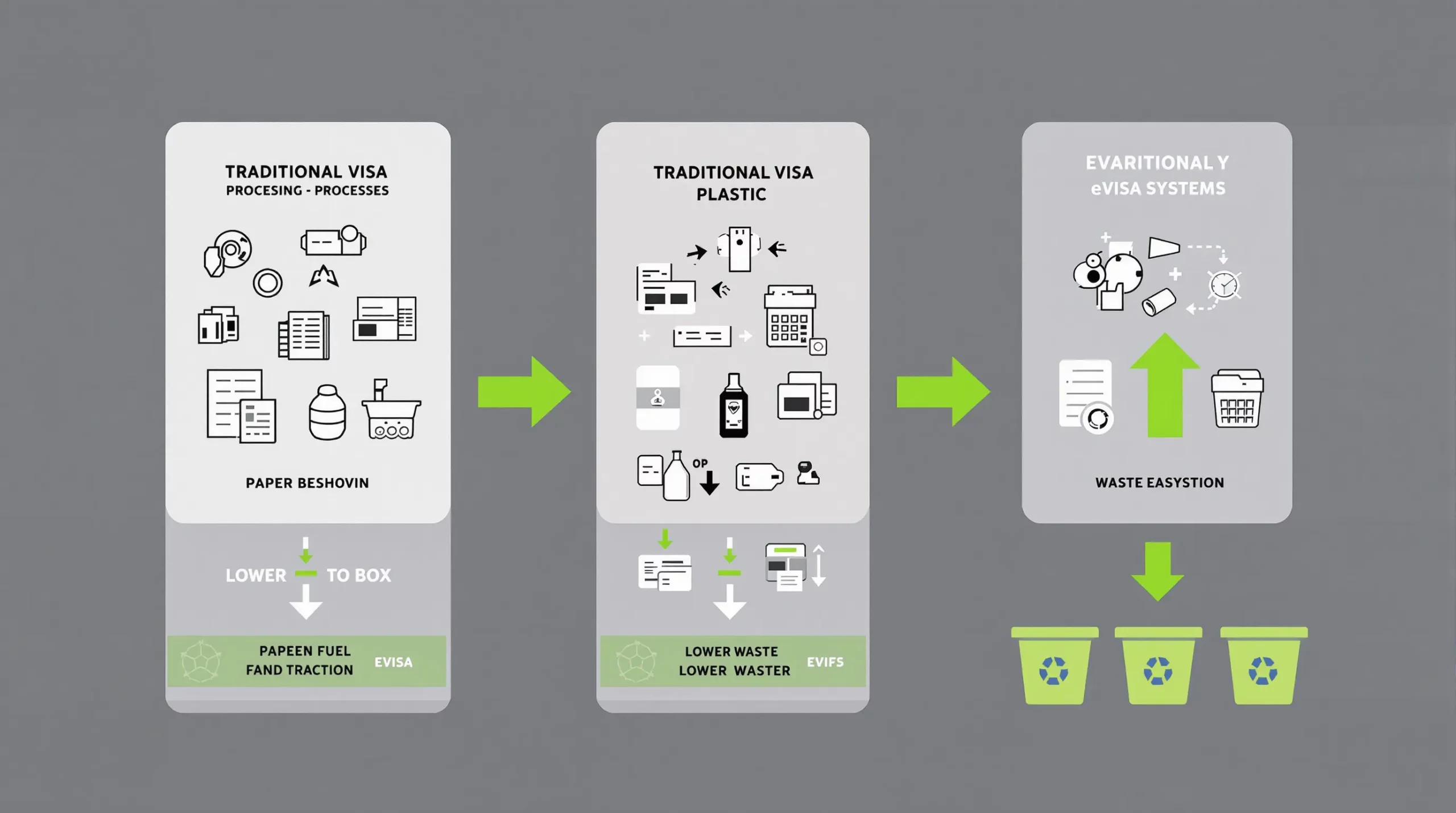The Environmental Impact of Electronic Visas vs. Embassy Visits

A greener passport to the world
Sustainability has moved from a nice-to-have to a core metric across the travel value chain. Airlines publish SAF roadmaps, hotels tout water-saving fixtures, and even frequent flyers track the carbon cost of each leg. Yet one touchpoint is often forgotten: the visa application itself. Is a stamped passport page obtained after driving (or flying) to an embassy still compatible with net-zero ambitions? Or do electronic visas (eVisas) quietly cut a sizeable chunk of emissions and waste? Let us unpack the data.
The hidden footprint of a traditional embassy visit
Before the first page of a passport is stamped, most travelers already leave a trail of emissions:
- Transportation to the embassy or consulate: A 40 km round-trip car ride emits roughly 8 kg of CO₂ according to the US EPA average of 0.2 kg per km for passenger vehicles. International applicants who need to fly to a regional consulate can add hundreds of kilograms more.
- Courier services for mailed applications: Overnight shipping of a passport (0.5 kg package, 400 km average distance) adds about 1.2 kg of CO₂ per leg (Scope 3 DHL data, 2024).
- Paper usage: A single visa dossier often contains 20-40 printed pages plus two passport photos. Producing one sheet of A4 paper requires 10 L of water and emits 5 g of CO₂ (European Paper Recycling Council, 2023). Multiply by millions of applicants and the numbers grow fast.
- Facility operations: Embassies need waiting rooms, lighting and staffed counters just to receive applicants. A 2019 UK Foreign Office audit estimated 27 MWh of electricity per visa center per year—roughly the annual consumption of 6 average homes.
Put together, a standard business visa appointment for an urban resident can easily exceed 10 kg of CO₂ and 200 L of water. Factor in long-distance travel or group applications and the footprint multiplies.

What changes with an electronic visa?
An eVisa converts all paperwork, biometric capture and payment into a fully digital workflow:
- Online form submission through a secure portal or API.
- Digital document upload (PDF scans instead of printed bank statements or letters).
- Automated background checks performed in government data centers.
- Electronic issuance—the authorization is linked to the passport number and pushed to airline and border systems.
The only physical component left is the traveler’s computer or phone and the hosting infrastructure that powers the application.
Quantifying the digital footprint
- Data transfer and storage: A typical eVisa application (documents and biometric photo) is under 20 MB. Using the widely cited figure of 0.2 g CO₂ per GB transferred (Shift Project, 2022), the network footprint is 0.004 g—orders of magnitude lower than paper printing.
- Server processing: Public cloud providers such as AWS report 0.00017 kg CO₂e per compute hour for a Western Europe data center running on 89 percent renewable energy (Amazon Sustainability Report, 2024). Even conservative estimates place a single eVisa transaction at under 1 g of CO₂.
In other words, an eVisa shaves roughly 99 percent of greenhouse-gas emissions compared with a typical in-person appointment.
Case study: short-haul flight vs. digital submission
Consider a traveler from Lima who must obtain a visa at the Chilean consulate in Santiago. The cheapest option is a same-day flight (2 h each way, 4 h total). Based on ICAO emissions calculators, the round trip generates 410 kg of CO₂e. A remote eVisa process would avoid the flight entirely, resulting in a reduction equivalent to:
- The annual electric consumption of 68 laptops, or
- Planting 7 new trees and letting them grow for 10 years.
Switching 50 000 Peruvian applicants to eVisas would save 20 500 t of CO₂e—close to the yearly footprint of a small town.
Beyond carbon: resources, waste and time
- Paper and ink: Global visa forms consume an estimated 1.2 billion sheets annually (UNWTO Visa Openness Report, 2022). Eliminating them would spare 120 000 mature trees and 12 billion L of water used in pulp production.
- Plastic and courier packaging: Fewer passport shipments mean fewer poly-bags, air pockets and tamper-evident sleeves ending up in landfill.
- Human time: Digital self-service cuts queueing and second visits for corrections, saving millions of hours across applicants and consular staff. Time is not a direct environmental metric, but reduced commuting lowers rush-hour congestion and associated emissions.

The knock-on benefits for governments and travel companies
- Cost-efficient diplomacy: Digital consular services let governments relocate staff from expensive downtown offices to automated cloud platforms, reducing building energy needs.
- Resilience: Pandemics, extreme weather or strikes can close physical visa centers. eVisas keep borders operational with no added travel.
- Positive brand perception: Travelers increasingly factor sustainability into booking choices. Offering a paperless authorization can lift Net Promoter Score and repeat business.
How travel brands can leverage SimpleVisa for sustainability goals
SimpleVisa’s API and white-label app integrate eVisa eligibility checks and applications directly in the booking flow. For airlines and OTAs racing to meet Scope 3 targets, that means:
- Replacing embassy directions in confirmation emails with a one-click digital application.
- Displaying “kg CO₂ saved” badges next to itineraries to nudge greener choices.
- Unlocking ancillary revenue per booking while aligning with ESG reporting frameworks like GRI 305 (emissions) and SASB TR-CM 110a (environmental footprint).
Learn how our platform delivers on both revenue and responsibility in the article Electronic Visa : What are the benefits ?.
Frequently asked questions (FAQ)
Is an eVisa truly paperless?
Most issuing countries no longer require printed approvals, but a minority still ask travelers to carry a hard copy. Even in those cases, total paper use drops by over 90 percent.
What about the energy used by data centers?
Leading cloud regions now run on 80-100 percent renewable power. Their residual emissions per application are measured in grams, far below any physical alternative.
Do biometric requirements offset the savings?
No. Digital facial recognition or fingerprint capture is done via smartphone or airport kiosk already powered by the terminal’s grid. No extra travel or paper is needed.
Can businesses include eVisa adoption in carbon accounting?
Yes. Under the GHG Protocol, shifting customer travel from in-person to digital processing counts as an avoided Scope 3 emission and can be included in sustainability reports.
What if a traveler still prefers an embassy?
Choice remains, but digital channels offer a lower-impact path. Highlighting environmental gains helps travelers make informed decisions.
Ready to shrink your carbon ledger while boosting ancillary revenue? Book a live demo of SimpleVisa and see how our plug-and-play eVisa platform can green your booking flow today.